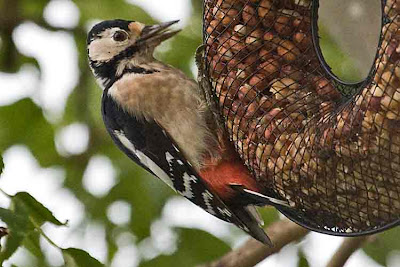Yellow-browed Warblers are elusive little beasts and this year has been particularly frustrating. The have a distinctive call and at times call persistently and loudly. The quite suddenly silence. After a time, sometimes hours, another burst of calling will come, only to stop again when your tracking the bird down. When news came through that Steve Reynaert, aka Walmer Wildlifer had found one at Kingsdown I decided to go and give another one the chance to see me while I missed it.
Today was a bit kinder and when I arrived Gerald Segelbacher and Steve were watching where it had be just a few minutes before. It wasn't a very long wait before it appeared all too briefly, but the wing bars and supercilium were well seen and with the smaller size these separate it from the several Chiffchaffs feeding in the same trees.
Some Yellow-broweds show a central crown stripe, not as bright or large as on a Pallas's but still quite distinct, this one showed little sign of such a feature.
As a group Phylloscopus (leaf) Warblers can be quite tricky, both Greenish and Arctic show pale superciliums and wing bars. The small size of the Yellow-browed might not always be obvious but the dark centred tertials, with broad pale edges are a good feature not shown by the others. The most similar species is Hume's Leaf Warbler, which was considered con-specific until quite recently. There are plumage differences, but the best feature, provided it obliges is the call. Steve's rather better pictures are here
Otter birds around today included quite a few Redpolls, that occasionally dropped down to feed before moving on.
The garden was busy and to some extent reflected the movement of birds we'd been seeing around the patch, but still not Yellow-browed coming down to drink. Instead I had to make do with a couple of Chiffchaffs.
One Brambling perched in front of my study window.I had to photograph it through the glass so as not to disturb it. Later I could her it or another calling from the trees.
There's been a lot of news of a large movement of Blue Tits in Scandinavia. There seem to have been quite a few around Bockhill and in the garden this afternoon, but I suspect they are our local population and that knowing there's a possible irruption has made us more aware of them.
At this time of year the feeding Goldfinch flock in the garden starts to build up. Last year it got to several hundred and the got through quite of few kilos of sunflower seeds over the two or three weeks they were with us in such large numbers.
So far this year there have only been around ten as a maximum and as in all seed eaters somewhere to drink is important.
Chaffinch numbers are still quite low, and when it comes to the feeders they are frequently ousted by the more robust Greenfinches. But, luckily for the Chaffinches, the other finches do tend to drop a lot under the feeders and they happily feed on the ground cleaning up the spillages.
Walking round today I saw and heard a few Great-spotted Woodpeckers. It is possible that we get some that move in from the continent. Although regarded as mainly resident I have seen them on Shetland climbing up a lighthouse in an area where there were no large trees. The one on my feeders are probably local birds, but it will be interesting to see if the numbers do increase, especially as I suspect the resident birds may remain territorial in the winter.
There have been few Song Thrushes in the garden this year despite the massive number of snails available due to the wet summer. One this evening, a first year bird (the row of pale tips on the coverts show this) may well be a migrant. Thrushes can arrive in good numbers. This morning we had a total of 11 Ring Ouzels arrive, including one party of seven, although as yet the other thrushes have been in short supply.
As with the Blue Tits, Great Tits have been much in evidence in the garden. Another mainly resident species that is sometimes joined by parties from over the channel.
On Friday I had a long walk orund with Guy Bailey. We had a pleasnt day, but were not rewarded with a lot of birds. One thing we did see was this Hobby, over Bockhill Farm. Now were are in the middle of October this might be the last one we see this year. They migrate to Africa, and the last ones tend to leave with the last Swallows, the form much of their diet.
















No comments:
Post a Comment